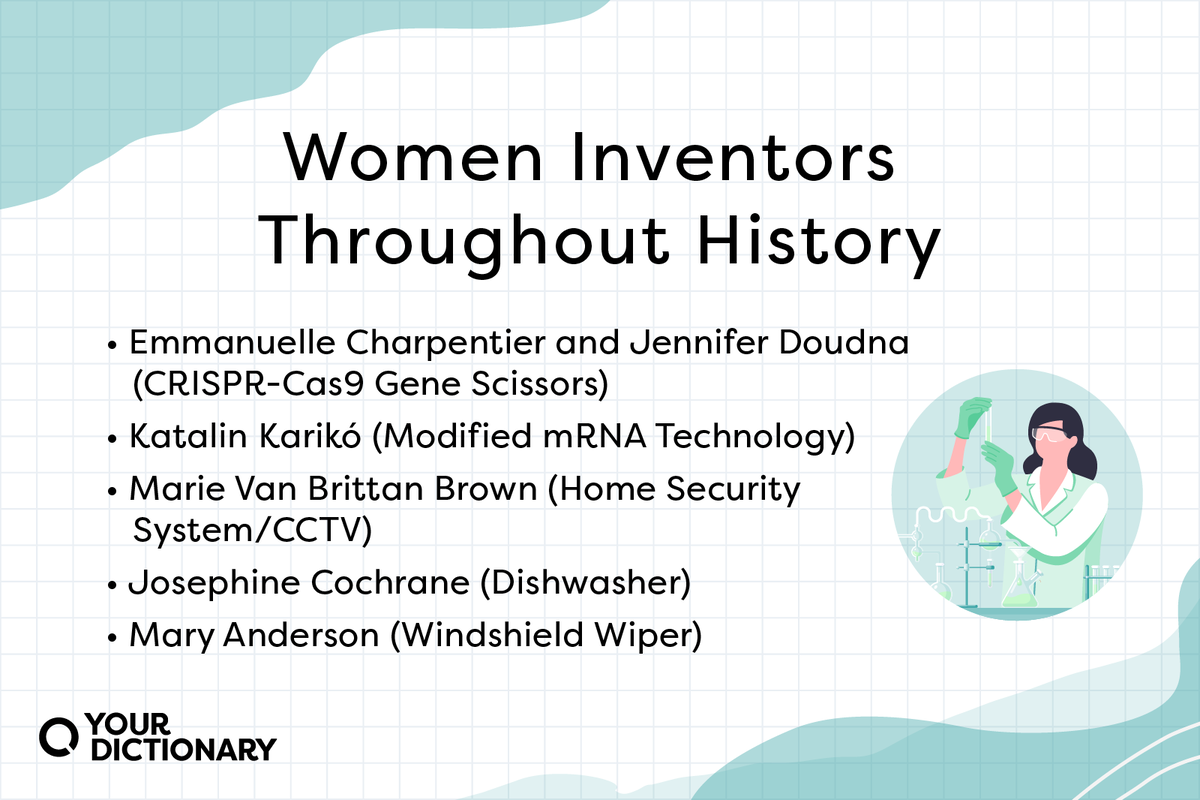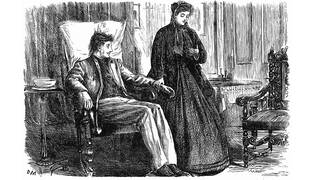
When you think of inventors, images of Thomas Edison, Alexander Graham Bell, or Leonardo da Vinci probably come to mind. But what about Josephine Cochrane, Mary Anderson, and Jennifer Doudna?
Women inventors and their innovations have fundamentally changed the ways we conduct scientific research, run a household, and build infrastructure — even though you may not know much about them.
Female Inventors of the 20th and 21st Centuries
Innovative women created a number of incredible inventions during the late 20th and 21st centuries. From DNA amplification to shapewear to body armor, these women have forever changed our future.
Emmanuelle Charpentier and Jennifer Doudna (CRISPR-Cas9 Gene Scissors)
Emmanuelle Charpentier and Jennifer Doudna received the Nobel Prize in Chemistry in 2020 for inventing a method for high-precision genome editing.
They repurposed CRISPR-Cas9 gene technology to use it like scissors when modifying DNA. After discovering the process in 2013, the researchers were named in Time magazine’s 100 Most Influential People of the Year list in 2015.
Katalin Karikó (Modified mRNA Technology)
Dr. Katalin Karikó’s genetic research was essential in developing the messenger RNA technology needed for the COVID-19 vaccine. With collaborator Drew Weissman at University of Pennsylvania, Karikó innovated the idea of using non-synthetic mRNA to fight infectious disease.
Her research began more than 25 years before the COVID-19 pandemic and continues to influence medical technology today.
Charlotte McCurdy (Carbon Negative Raincoat)
Designer and researcher Charlotte McCurdy used algae to develop a material similar to plastic, and then used that material to design a carbon-negative raincoat.
The raincoat design won first place in the "experimental category" in Fast Company's 2019 Innovation by Design awards program. Through her industrial design work, McCurdy seeks to demonstrate practical solutions to the threat of climate change.
Ann Lambrechts (Steel Wire Reinforced Concrete)
In 2000, Belgian inventor Ann Lambrechts created a way to strengthen reinforced concrete and make it more stable by adding steel wire to it. As an alternative to bulky and expensive rebar, steel wire opens up architectural possibilities while also reducing construction costs.
Lambrechts received the 2011 European Inventor award for this innovation.
Sara Blakely (SPANX)
Sara Blakely, founder of SPANX, came up with her invention while getting dressed for a party. Her wardrobe lacked an undergarment that would provide her with a smooth look under slacks, so she was inspired to snip the feet off a pair of control-top pantyhose and used them.
Thus began the idea for SPANX, which began in 1998 with an initial $5,000 investment. In 2012, Forbes named Blakely the youngest self-made female billionaire in the world.
Jyothikaa Ramann (The Posture Genie)
Jyothikaa Ramann, a 10th-grade student from Dougherty Valley High School in California, invented a posture-correcting device that provides a buzz of feedback whenever the wearer starts to slump.
Ramann received the Most Innovative Award at the 2020 California Invention Convention for her creation.
Margarita Salas Falgueras (DNA Amplification)
Between 1997 and 2017, Margarita Salas Falgueras, Ph.D., secured four patents to develop a reliable and accurate method to replicate DNA called DNA amplification.
Falgueras’s innovations led to significant advances in forensic science, medicine (especially oncology), and anthropology. In 2019, the European Patent Office recognized her with a lifetime achievement award.
Dr. Patricia Bath (Laserphaco Probe)
Ophthalmologist Dr. Patricia Bath invented the Laserphaco Probe in 1981 and patented it in 1988. This laser tool greatly improved cataract surgery by making it less invasive and more precise.
Not only is Dr. Bath among the most influential Black women inventors of the modern era, she was also the first female faculty member in the College of Medicine at the University of California Los Angeles (UCLA) and the first female chair of the Charles R. Drew/UCLA Medical Education Program.
Lisa Lindahl (Sports Bra)
In 1979, Lisa Lindahl patented the sports bra, which was first sold under the name Jogbra. She and friend Polly Smith designed the bra to provide proper support without chafing or slipping straps, using breathable fabric.
Along with Linda Miller, Lindahl founded Jogbra, Inc. to bring the product to market. They ultimately sold the company to Playtex.
Marie Van Brittan Brown (Home Security System/CCTV)
Marie Van Brittan Brown, a visionary Black inventor, was working late nights as a nurse when she wanted to improve the safety of her home. She invented (1966) and received a patent (1969) for the first home security system with assistance from her electronics technician husband.
It functioned as what came to be known as CCTV (closed-circuit television system), which she is also credited with inventing. She is considered a visionary African American inventor.
Stephanie Kwolek (Kevlar)
In 1965, Stephanie Kwolek, a chemist at DuPont, conducted research on polyamide molecules that led to the invention of Kevlar, a revolutionary industrial fiber. Kevlar has five times the strength of steel while being lighter than fiberglass.
Kevlar was first used in the 1970s in racing tires (to replace much heavier steel). It is now used in many commercial products, including life-saving items like body armor, bulletproof vests, and helmets.

First Female Doctors Around the World
Great Female Inventors in History
Just like male inventors throughout history, female inventors found opportunities to improve their lives — and the lives around them — with innovative creations.
Judy Reed (Dough Kneader/Roller)
Judy Reed was the first known Black woman to receive a patent in the United States. The Washington, D.C. resident applied for and received a patent for her dough kneader and roller device in 1884.
Her device improved previous designs by ensuring more even mixing.
Sarah Boone (Improved Ironing Board)
In 1892, dressmaker Sarah Boone received a patent for a new ironing board design (first invented in 1858). Her design was crafted specifically to simplify the process of ironing the bodice and sleeve portions of ladies' dresses.
Boone, who had been born into enslavement, was freed along with her husband shortly after their 1847 marriage. She is believed to have been the second African American woman to receive a patent in the United States.
Josephine Cochrane (Dishwasher)
During the early 1880s, Josephine Cochrane invented the first dishwasher that became a commercial success. After working for a few years to perfect the design, she filed for a patent in 1885 and received it in 1886.
She founded Cochran’s Crescent Washing Machine Company, through which she brought the product to market. It quickly caught on with businesses, though it was not widely adopted in the consumer market.
Mary Anderson (Windshield Wiper)
In 1903, Mary Anderson received a patent for a "window cleaning device." She was inspired to invent this device as a result of traveling by trolley and streetcar in New York City.
She observed that drivers had no way to clear the windows from inside. During snow or rain, drivers had to get out of the vehicle to clean the windows or drive with their head hanging out of a window.
She came up with an innovative solution to that problem, which became the first effective windshield wiper.
Nancy M. Johnson (Ice Cream Maker)
In 1843, Nancy M. Johnson of Philadelphia, Pennsylvania patented the hand crank ice cream freezer. It featured a center paddle and a hand crank on the outside of the container that made ice cream much easier to stir.
A similar version to her original device is still sold in modern times, as some people prefer hand-crank rather than electric ice cream makers.
Fast Fact
Who was the first woman to invent something?
In 1809, Mary Kies became the first woman to receive a U.S. patent for invention when she discovered a new method to weave straw with silk.
While she was certainly not the first woman to ever invent something, Kies was the first woman who could legally claim ownership of her own invention.